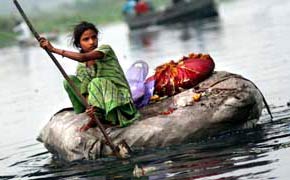The rivers die in India
The Indian economy is growing rapidly and the problem of environmental pollution is also getting worse. So many rivers in India are dying.
From the dim light Somnath Dantoso, 12, sat on a floating garbage raft on the Yamuna River in New Delhi, holding a lever on his head with a magnet attached. This need can be as deep as 9 meters. On the days of 'smooth sailing,' I can collect about 50 rupees (about a few tens of thousands of VND), which are thrown into the river by believers. For four years Somnath has been quite proficient with the profession of "smoking money".
Dantoso said: "As long as people do not throw away money from the river, I will quit this job and will open a food store. Otherwise I will do this job for life."
In fact, the Yamuna River is not the only coin. The rivers in India are a huge garbage raft. 57% of the city's waste falls on the Yamuna River. Rubbish drifted along the river, the smell of gas rose sharply. This river is 1,376 km long and runs to the foot of the Himalayas. The amount of garbage flowing into the river from 1993 to 2005 has doubled and thus the already polluted Indian rivers are even more polluted.

An Indian girl on the Yamuna River is heavily polluted.(Photo: Spiegel.de)
Sunita Narain, director of the New Delhi Center for Science and Environment, said: "The river is dead, it is only missing, it is not officially cremated." But the Yamuna River is not an exception. In India about 80% of municipal waste is dumped into the river. This situation is getting worse because the government is unable to control the overloading of cities. More and more water areas in India cannot be used for bathing or drinking water. Even to the Ganges River, a river that is considered sacred by Hindus, is so heavily polluted that the dolphins living here are at risk of genocide.
Air pollution is also getting worse. It is even thought that dust in India affects the weather in North America. Air pollution heavily affects Indian agriculture. Rice productivity in southern India decreased markedly when brown clouds covered the sky.
According to Indian environmental expert Shreekant Gupta, India's gross domestic product will be reduced by 4% if the environmental harms are taken into account. The main reason is due to environmental factors causing death and disease. In India the main cause of death for children is due to water pollution.
The biggest problem with pollution of rivers is that almost all of India's waste water flows into rivers that are completely untreated. Analysis of water samples collected in the Ganges near Varanasi city shows that dangerous levels of Coli are higher than the permitted level by 3,000%.
Delhi has 15 million inhabitants, only 55% of the population lives in areas with wastewater treatment. The rest of the waste water flows straight into the Yamuna River.
Not Indians are not aware of the risk of water pollution as well as problems related to the Yamuna River. India has spent Rs 20 billion (about 360 million euros) on water purification works, in addition India has invested large sums of money to treat wastewater systems. But not so that the water is cleaner. 11 out of 17 wastewater treatment facilities are not operating at full capacity, about 1/4 of factories only run at less than 30% of capacity, the main reason is the canal system, sewers do not bring enough wastewater to the system. The system handles because of clogging and damage.
Rapid population growth has created more and more slums and now in New Delhi there are more than 1,500 new residential areas, out of planning, discharging innocent water into canals and rivers.
There are currently eight municipal government agencies, the federal government and the government overseeing various areas related to the treatment of the Yamuna river pollution. These agencies compete with each other for budgeting but always push each other on responsibility whenever the pollution problem rises in public opinion.
Viet Phuong
- Marvel at the source of the 10 great rivers in the world
- Rivers are infected with antibiotics
- India plans to change the Ganges River to cope with the record drought
- Confluent rivers are not suitable for color matching
- In the north, there is a widespread rain, and floods appear on the rivers
- Interesting little facts about India
- 10 'dying' rivers of America (Part 1)
- 10 major rivers in the world are under threat
- Scientist 'went out' to clean up rivers and lakes
- Two more rivers disappeared after only one night in Mexico
- Floods in India, 77 people were killed
- 1,000 dead ducks floating rivers in China
 Is the magnetic North Pole shift dangerous to humanity?
Is the magnetic North Pole shift dangerous to humanity? Washington legalizes the recycling of human bodies into fertilizer
Washington legalizes the recycling of human bodies into fertilizer Lightning stone - the mysterious guest
Lightning stone - the mysterious guest Stunned by the mysterious sunset, strange appearance
Stunned by the mysterious sunset, strange appearance